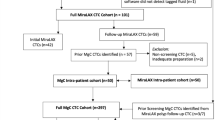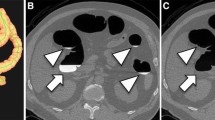Abstract
Objective
We aimed to compare iohexol vs. diatrizoate as fecal/fluid tagging agents for computed tomography colonography (CTC) regarding examination quality.
Methods
Forty prospective patients (M:F = 23:17; 63 ± 11.6 years) received CTC using 50 mL (350 mgI/mL) oral iohexol for tagging. Forty other indication-matched, age-matched, and sex-matched patients who underwent CTC using 100 mL diatrizoate for tagging and otherwise the same technique, were retrospectively identified. Two groups were compared regarding overall examination quality, per-patient and per-segment scores of colonic bubbles (0 [no bubbles] to 5 [the largest amount]), and the volume, attenuation, and homogeneity (untagged, layered, and homogeneous) of the residual colonic fluid.
Results
The iohexol group demonstrated a greater amount of colonic bubbles than the diatrizoate group: mean per-patient scores ± SD of 1.2 ± 0.8 vs. 0.7 ± 0.6, respectively (p = 0.003); and rates of segments showing ≥ grade 3 bubbles of 12.9 % (85/659) vs. 1.6 % (11/695), respectively (p = 0.001). Residual colonic fluid amount standardized to the colonic volume did not significantly differ: 7.2 % ± 4.2 vs. 7.8 % ± 3.7, respectively (p = 0.544). Tagged fluid attenuation was mostly comparable between groups and the fluid was homogeneously tagged in 98.7 % (224/227) vs. 99.5 % (218/219) segments, respectively (p = 0.344). Iohexol caused more colonic bubbles when used during cathartic CTC. Otherwise, examination quality was similarly adequate with both iohexol and diatrizoate.
Key Points
• When used for tagging, iohexol caused significantly more colonic bubbles than diatrizoate.
• The residual colonic fluid amount did not significantly differ between iohexol and diatrizoate.
• The quality of fluid tagging was similarly adequate in both iohexol and diatrizoate.



Similar content being viewed by others
References
Park SH, Yee J, Kim SH, Kim YH (2007) Fundamental elements for successful performance of CT colonography (virtual colonoscopy). Korean J Radiol 8:264–275
Neri E, Halligan S, Hellstrom M, Lefere P, Mang T, Regge D et al (2013) The second ESGAR consensus statement on CT colonography. Eur Radiol 23:720–729
Yee J (2009) CT colonography: techniques and applications. Radiol Clin N Am 47:133–145
Zalis ME, Perumpillichira JJ, Magee C, Kohlberg G, Hahn PF (2006) Tagging-based, electronically cleansed CT colonography: evaluation of patient comfort and image readability. Radiology 239:149–159
Nagata K, Singh AK, Sangwaiya MJ, Nappi J, Zalis ME, Cai W et al (2009) Comparative evaluation of the fecal-tagging quality in CT colonography: barium vs. iodinated oral contrast agent. Acad Radiol 16:1393–1399
Bayer. Bayer's product. Available via http://www.bayerresources.com.au/resources/uploads/PI/file9348.pdf. Accessed 1 Aug 2014
Horton KM, Fishman EK, Gayler B (2008) The use of iohexol as oral contrast for computed tomography of the abdomen and pelvis. J Comput Assist Tomogr 32:207–209
McNamara MM, Lockhart ME, Fineberg NS, Berland LL (2010) Oral contrast media for body CT: comparison of diatrizoate sodium and iohexol for patient acceptance and bowel opacification. AJR Am J Roentgenol 195:1137–1141
Peterson CM, Lin M, Pilgram T, Heiken JP (2011) Prospective randomized trial of iohexol 350 versus meglumine sodium diatrizoate as an oral contrast agent for abdominopelvic computed tomography. J Comput Assist Tomogr 35:202–205
Pollentine A, Ngan-Soo E, McCoubrie P (2013) Acceptability of oral iodinated contrast media: a head-to-head comparison of four media. Br J Radiol 86:20120636
Stordahl A, Laerum F, Gjolberg T, Enge I (1988) Water-soluble contrast media in radiography of small bowel obstruction. Comparison of ionic and non-ionic contrast media. Acta Radiol 29:53–56
Dachman AH (2011) Scheduling, performing, and reporting computed tomographic colonography. In: Dachman AH, Laghi A (eds) Atlas of virtual colonoscopy, 2nd edn. Springer, Berlin, pp 87–109
Lenhart DK, Johnston RP, Zalis ME (2011) Patient preparation and tagging. In: Dachman AH, Laghi A (eds) Atlas of virtual colonoscopy, 2nd edn. Springer, Berlin, pp 79–86
Zalis ME, Blake MA, Cai W, Hahn PF, Halpern EF, Kazam IG et al (2012) Diagnostic accuracy of laxative-free computed tomographic colonography for detection of adenomatous polyps in asymptomatic adults: a prospective evaluation. Ann Intern Med 156:692–702
Hong GS, Park SH, Kim B, Lee JH, Kim JC, Yu CS et al (2014) Simethicone to prevent colonic bubbles on CT colonography performed with PEG lavage and iohexol tagging: a randomized clinical trial. AJR Am J Roentgenol. doi:10.2214/AJR.14.13024
Zalis ME, Barish MA, Choi JR, Dachman AH, Fenlon HM, Ferrucci JT et al (2005) CT colonography reporting and data system: a consensus proposal. Radiology 236:3–9
Lee SS, Park SH, Kim JK, Kim N, Lee J, Park BJ et al (2009) Panoramic endoluminal display with minimal image distortion using circumferential radial ray-casting for primary three-dimensional interpretation of CT colonography. Eur Radiol 19:1951–1959
Dachman AH, Zalis ME (2004) Quality and consistency in CT colonography and research reporting. Radiology 230:319–323
Lefere P, Gryspeerdt S, Baekelandt M, Van Holsbeeck B (2004) Laxative-free CT colonography. AJR Am J Roentgenol 183:945–948
Taylor SA, Slater A, Burling DN, Tam E, Greenhalgh R, Gartner L et al (2008) CT colonography: optimisation, diagnostic performance and patient acceptability of reduced-laxative regimens using barium-based faecal tagging. Eur Radiol 18:32–42
ACR Committee on Drugs and Contrast Media (2013) ACR Manual on Contrast Media Version 9, 2013. Available via http://www.acr.org/~/media/ACR/Documents/PDF/QualitySafety/Resources/Contrast%20Manual/2013_Contrast_Media.pdf. Accessed 1 Aug 2014
Jamialahmadi M, Zehtaban M, Müller-Steinhagen H, Sarrafi A, Smith J (2001) Study of bubble formation under constant flow conditions. Chem Eng Res Des 79:523–532
Mattei P (2011) Meconium ileus. In: Mattei P (ed) Fundamentals of pediatric surgery. Springer, Berlin, p 395
Bannas P, Bakke J, Patrick JL, Pickhardt PJ (2014) Automated volumetric analysis for comparison of oral sulfate solution (SUPREP) with established cathartic agents at CT colonography. Abdom Imaging
Chung S-Y, Park SH, Lee SS, Lee JH, Kim AY, Park S-K et al (2012) Comparison between CT colonography and double-contrast barium enema for colonic evaluation in patients with renal insufficiency. Korean J Radiol 13:290–299
Neri E, Lefere P, Gryspeerdt S, Bemi P, Mantarro A, Bartolozzi C (2013) Bowel preparation for CT colonography. Eur J Radiol 82:1137–1143
Gentile M, De Rosa M, Cestaro G, Forestieri P (2013) 2 L PEG plus ascorbic acid versus 4 L PEG plus simethicon for colonoscopy preparation: a randomized single-blind clinical trial. Surg Laparosc Endosc Percutan Technol 23:276–280
Keedy AW, Yee J, Aslam R, Weinstein S, Landeras LA, Shah JN et al (2011) Reduced cathartic bowel preparation for CT colonography: prospective comparison of 2-L polyethylene glycol and magnesium citrate. Radiology 261:156–164
Ponchon T, Boustiere C, Heresbach D, Hagege H, Tarrerias AL, Halphen M (2013) A low-volume polyethylene glycol plus ascorbate solution for bowel cleansing prior to colonoscopy: the NORMO randomised clinical trial. Dig Liver Dis 45:820–826
Valiante F, Pontone S, Hassan C, Bellumat A, De Bona M, Zullo A et al (2012) A randomized controlled trial evaluating a new 2-L PEG solution plus ascorbic acid vs. 4-L PEG for bowel cleansing prior to colonoscopy. Dig Liver Dis 44:224–227
Altintas E, Ucbilek E, Sezgin O, Sayici Y (2008) Alverine citrate plus simethicone reduces cecal intubation time in colonoscopy—a randomized study. Turk J Gastroenterol 19:174–179
Lazzaroni M, Petrillo M, Desideri S, Bianchi Porro G (1993) Efficacy and tolerability of polyethylene glycol-electrolyte lavage solution with and without simethicone in the preparation of patients with inflammatory bowel disease for colonoscopy. Aliment Pharmacol Ther 7:655–659
Matro R, Tupchong K, Daskalakis C, Gordon V, Katz L, Kastenberg D (2012) The effect on colon visualization during colonoscopy of the addition of simethicone to polyethylene glycol-electrolyte solution: a randomized single-blind study. Clin Transl Gastroenterol 3:e26
McNally PR, Maydonovitch CL, Wong RK (1988) The effectiveness of simethicone in improving visibility during colonoscopy: a double-blind randomized study. Gastrointest Endosc 34:255–258
McNally PR, Maydonovitch CL, Wong RK (1989) The effect of simethicone on colonic visibility after night-prior colonic lavage. A double-blind randomized study. J Clin Gastroenterol 11:650–652
Shaver WA, Storms P, Peterson WL (1988) Improvement of oral colonic lavage with supplemental simethicone. Dig Dis Sci 33:185–188
Sudduth RH, DeAngelis S, Sherman KE, McNally PR (1995) The effectiveness of simethicone in improving visibility during colonoscopy when given with a sodium phosphate solution: a double-bind randomized study. Gastrointest Endosc 42:413–415
Tongprasert S, Sobhonslidsuk A, Rattanasiri S (2009) Improving quality of colonoscopy by adding simethicone to sodium phosphate bowel preparation. World J Gastroenterol 15:3032–3037
Wu L, Cao Y, Liao C, Huang J, Gao F (2011) Systematic review and meta-analysis of randomized controlled trials of Simethicone for gastrointestinal endoscopic visibility. Scand J Gastroenterol 46:227–235
Hassan C, Bretthauer M, Kaminski MF, Polkowski M, Rembacken B, Saunders B et al (2013) Bowel preparation for colonoscopy: European Society of Gastrointestinal Endoscopy (ESGE) guideline. Endoscopy 45:142–150
Acknowledgments
The scientific guarantor of this publication is Dr. Hyun Kwon Ha. Seong Ho Park received research grants from GE Healthcare for the present study and Dongkook Pharmaceutical for work unrelated to the present study. All other authors of this manuscript declare no relationships with any companies, whose products or services may be related to the subject matter of the article. This study was supported by GE Healthcare and the Technology Innovation Program (no.10043072), which is funded by the Ministry of Trade, Industry and Energy (MOTIE, Korea). Seong Ho Park has significant statistical expertise. Approval by the Institutional Review Board of the Asan Medical Center was obtained. Written informed consent was obtained from all relevant patients in this study. Methodology: retrospective, observational, performed at one institution.
Author information
Authors and Affiliations
Corresponding author
Rights and permissions
About this article
Cite this article
Kim, B., Park, S.H., Hong, GS. et al. Iohexol versus diatrizoate for fecal/fluid tagging during CT colonography performed with cathartic preparation: comparison of examination quality. Eur Radiol 25, 1561–1569 (2015). https://doi.org/10.1007/s00330-014-3568-0
Received:
Revised:
Accepted:
Published:
Issue Date:
DOI: https://doi.org/10.1007/s00330-014-3568-0




